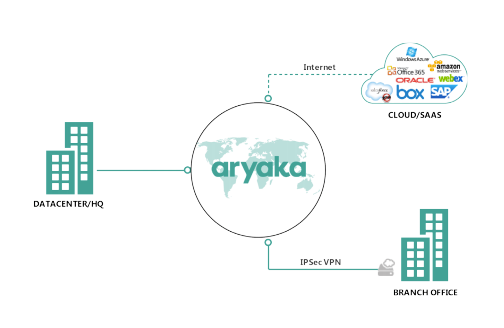Is WAN connectivity slowing you down? Here’s the solution…

Negotiate network contracts, configure equipment, deploy solution, address user complaints, fix problems, and… repeat.
Does this sound familiar? Enterprises with multiple locations around the country, or the world, constantly deal with an endless cycle of recurring WAN connectivity challenges. Every time a new branch office opens, this dreaded cycle begins anew.
It’s not effective.
It’s not productive.
It’s not cost-efficient.
And it’s not a good way to run a business.
Internal network costs and complexities continue to increase
According to Gartner, organizations spend 22% of their IT budget on networking (CapEx and OpEx). Trying to achieve network agility, performance, and security with legacy technologies will only continue to burden your IT team. This will keep them preoccupied, and unable to work on strategic initiatives that would benefit the business.
The network shouldn’t restrain business
Network complexities cost businesses time, money, and lost opportunities. For example, making network configuration changes in branch offices requires technical IT personnel to manually configure equipment on-site, at each location. Rolling out new on-premises applications in branch offices means more bandwidth may be needed. Migrating applications and workloads to the cloud translates to another level of complexity, requiring IT to re-evaluate network architectures. And there will need to be continued maintenance of network equipment, and ongoing management at each branch.
 Complexity is an obstacle that prevents network operations from supporting business opportunities.
Complexity is an obstacle that prevents network operations from supporting business opportunities.
Legacy networks are rigid, and were not designed to handle the volume and diversity of today’s users and applications. The pace of business, and ever-changing business dynamics, requires network infrastructure to be on-demand, agile, and scalable.
New network technologies leverage business opportunities
Automating network services, and centrally managed software to enable the network to accommodate mission-critical requirements, are key to supporting business.
Services need to be rapidly spun-up, and must offer network and application-level visibility. These capabilities should be transparent and seamless to enterprise IT personnel.
The network should be a business enabler
There’s no need for enterprise IT departments to deal with CapEx-heavy hardware or device configuration changes. The trick is having a flexible global SD-WAN service platform that automates and scales network services on-demand.
Highly scalable virtualized network functions like routers, gateways, firewalls and more, can be centrally managed with intuitive software. And network traffic is automatically directed and managed with greater agility, reliability, and faster performance.
IT organizations transitioning data center functions to the cloud have unique requirements. Their cloud-based networks need the following capabilities:
- A global network with MPLS-grade quality and reliability
- End-to-end multi-layered security
- Accelerated application performance to SaaS, PaaS, and IaaS services
- WAN optimization embedded within the network to deliver applications fast
- Global SD-WAN functionality to reduce cost and complexity
- Easy and fast network deployment with on-demand scalability
A global SD-WAN service delivers all of the above. It removes network infrastructure as a business obstacle, and leverages an optimized global network to be a business opportunity enabler.

With Managed SD-WAN as-a-service, new applications can be easily and quickly deployed. Controlling and shaping bandwidth for each location is accomplished centrally. In fact, the entire WAN is centrally managed with policies, through a single UI. There’s no negotiating of new network contracts. The Managed SD-WAN is an on-demand subscription service, so it’s easy to increase your bandwidth anywhere in the world, when you need it.
Take Skullcandy for example
Audio manufacturer, Skullcandy, was facing latency and application performance issues over MPLS in Germany, China and Japan. Executive teams across different regions around the world could not collaborate effectively due to WAN performance issues. They were experiencing disconnects with their Telepresence application, and their cloud-based ERP, SAP Business ByDesign, was running slow.
Skullcandy addressed their performance issues by moving from MPLS to Aryaka’s global SD-WAN. Deployment was complete in hours and the results were phenomenal:
- Employees in Germany, China and Japan now experience predictable, stable and fast performance for all applications, consistent with user performance across the globe.
- Telepresence is now working seamlessly all over the world, regardless of global location.
- They observed up to 10x faster performance for their cloud-based ERP.
“Aryaka gives us much better flexibility, improves service levels, lowers overall cost, and simplifies our global environment,” said Mark Hopkins, Senior Director of IT at Skullcandy. “Overall it has been a big win for us!”
One of the advantages Skullcandy appreciates is the addition of Aryaka’s global service team that has become invaluable in supporting the company’s IT team. Another benefit in their choice of Aryaka, is up to 40% cost savings compared to MPLS, and no capital expenditure required.
If you’re tired of endless frustrations dealing with WAN problems, and network barriers that inhibit business productivity and opportunities, Aryaka’s global SD-WAN could be the solution you’re looking for.
Come speak with us about how Aryaka’s global SD-WAN can help you address global connectivity needs. You can also get started with a proof of concept today.







